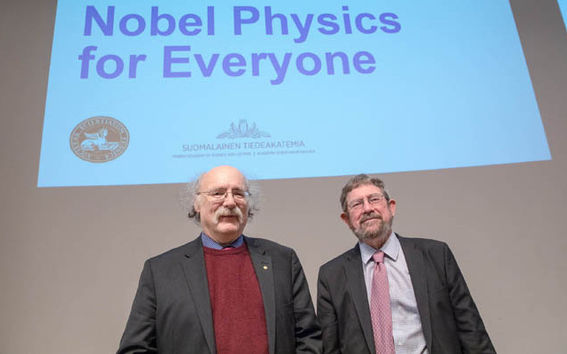Nobel physics for everyone

The recipients of the Nobel Prize in Physics 2016 Duncan Haldane and Michael Kosterlitz visited Aalto University at the invite of the Finnish Physical Society to hold a lecture. Their research as well as that of third Nobel recipient David Thouless deals with phase transitions of exotic matter and ways in which matter forms organised structures. This approach has become one of the cornerstones of present-day physics.
All three professors are British-born and currently work in the United States.
When introducing the lecture held in Hall U2 in Otaniemi,Professor Tero Heikkilä from the University of Jyväskylä spoke in Finnish about the Nobelists' field of research and gave some insight into what topology, the tool they utilise, actually is.
Doughnut is analogical with coffee cup
'The Nobel Prize was granted for theoretical discoveries of topological phase transitions and topological phases of matter. Topology is a branch of mathematics that explores the characteristics and variations of functions. From the perspective of topology, a doughnut is analogical with a coffee cup, because they have an equal number of holes. They have a certain stable characteristic that does not change,' Professor Heikkilä explains.
Quantum computers as a practical application
Duncan Haldane works as Professor of Physics at Princeton University in the United States. The research that led to this Nobel Prize began already in the 1970s. 'This work was theoretical for a long time. It was not clear that this was going to turn into something big. In the last few years, a multitude of different factors have come together and numerous consequences of this early work have become exciting new developments, like quantum computers', he says.
A matter of accidents
Michael Kosterlitz, Professor of Physics at Brown University, says that his research career is the result of many happy accidents. As a young postdoctoral researcher, he missed the deadline for applying to CERN and was left unemployed. He found a newspaper ad for a position at the University of Birmingham and got the job. Initially, his work there did not progress very well, but then he met David Thouless.
'At that time, going to Birmingham instead of CERN and studying condensed matter was the last thing I wanted to do, but it turned out to be the best move that could happen. I became interested in the subject after meeting Thouless, we collaborated, and the work we did led to us winning the Nobel Prize,' Kosterlitz explains.
'My career is the result of a series of happy accidents. It's not so much your skill and your brilliance that gets you famous but it's dumb luck,’ he continues.
Michael Kosterlitz has collaborated with Aalto University's Professor Tapio Ala-Nissilä and his research group for a number of years. The Nobelist was a Visiting Fellow at Aalto University at the time he got word that he had won the Nobel Prize.
Video from the event (wonderland.videosync.fi)
The physicists held a lecture for a full hall and took part in discussion with the audience after the event. .
Photos: Mikko Raskinen / Aalto University
Read more news

Get to know us: Associate Professor Maria Sammalkorpi
Sammalkorpi received her doctorate from Helsinki University of Technology 2004. After her defence, she has worked as a researcher at the Universities of Princeton, Yale and Aalto.
Aalto computer scientists in ICML 2024
Computer scientists in ICML 2024
Getting bacteria into line
Physicists use magnetic fields to manipulate bacterial behaviour